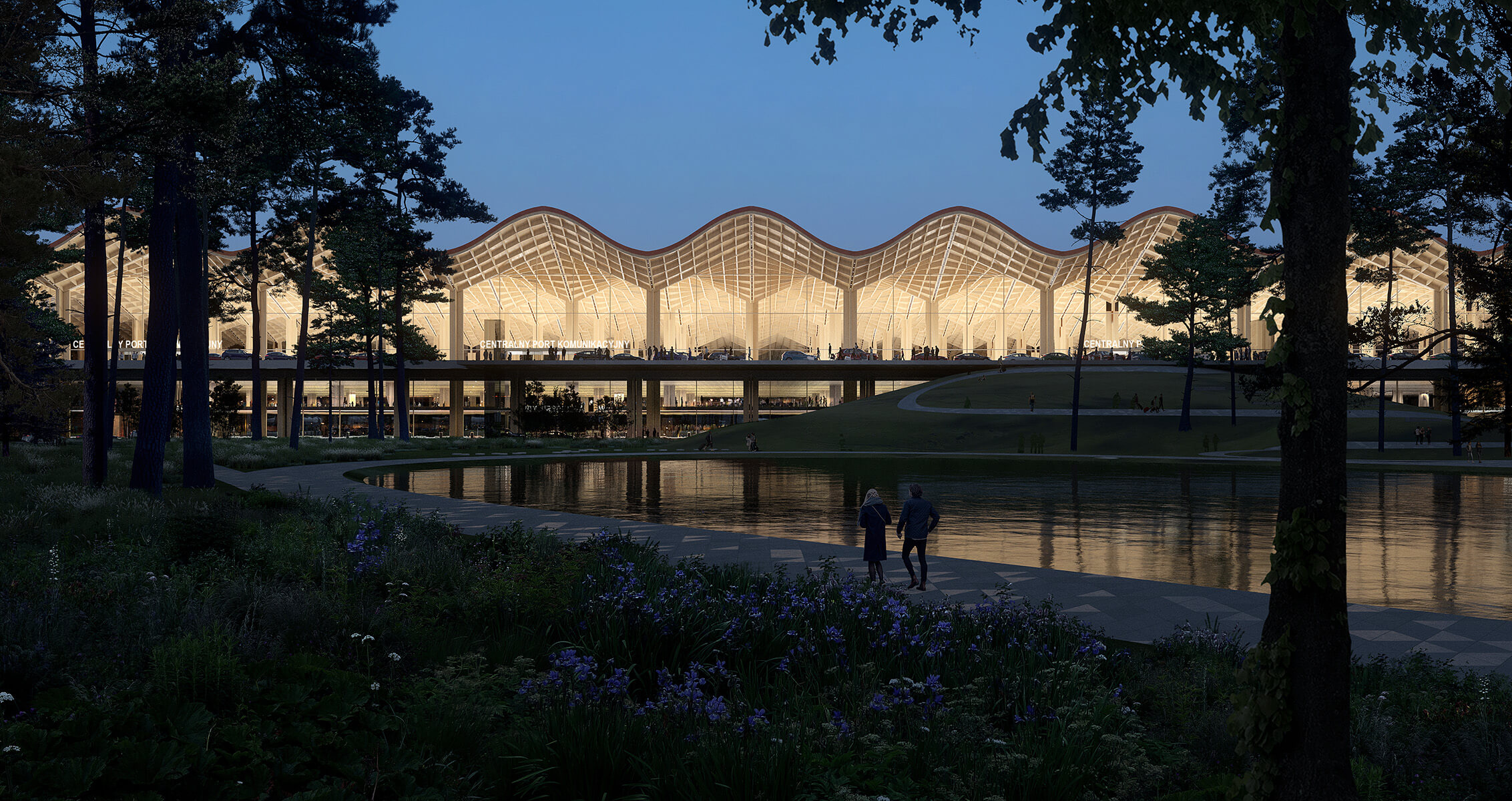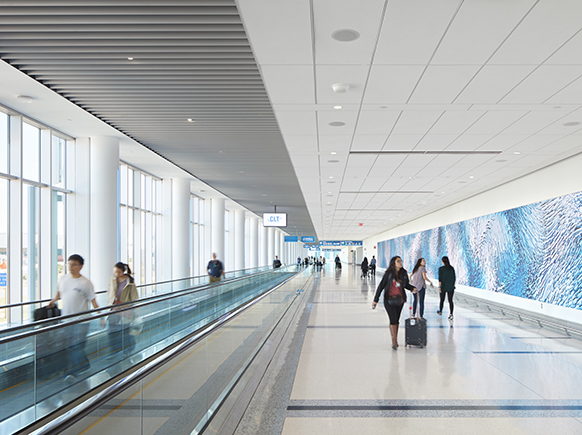Scott Gorenc: Jason, given your extensive expertise in sustainable design, I’m hoping you can share fresh ideas as we navigate the aviation industry’s complex challenges. How do you see the industry stepping up to better serve humanity and the ecosystems in which airports operate?
Jason McLennan: I approach this from the outside in, from an airport property’s furthest extent to the interiors of the terminal and other structures. At the landscape scale, it’s clear that airports’ significant environmental challenges arise in part because they occupy such large parcels and have so many regulatory constraints. They encompass vast expanses of impervious surfaces, leading to complex stormwater management issues and broader site impacts from chemicals used on planes and runways. Habitat disruption and wildlife interactions—particularly with birds—present unique ecological concerns.
The challenge lies in creating sustainable masterplans and landscapes that mitigate these risks rather than exacerbating them. From the outset, a holistic site response is crucial, and the Living Building Challenge offers a fundamentally different lens through which to address these issues. How can an airport create habitat and clean water?
Once we move inside airport terminals and support facilities, a host of other issues arise. Airports house energy-intensive operations, from restaurants and retail spaces to people and baggage handling systems and other essential infrastructure that is continuously operating. We’ve learned how to achieve radical reductions in energy use from many building types over the last few decades and it’s exciting to bring those best practices to airports now as well. It’s more than just efficient lighting! I’m talking about better solar control, all-electric facilities using geo-exchange and heat pumps, and a variety of innovative technologies designed to lower plug loads.
The scale of these facilities also presents opportunities. Expansive rooftops provide an ideal platform for renewable energy generation, and with thoughtful design, energy use can be significantly reduced and then matched with solar. It’s time to see net zero airports around the world.
Water usage is another substantial challenge due to the high volumes of traffic (we all know how much airport bathrooms get used) as well as food service and cleaning, but even this can be managed differently. Many airports already adopt water-saving features, but it’s possible to go above and beyond by capturing rainwater for all non-potable uses and treating water onsite. In fact, some airports already operate their own water and waste treatment facilities, demonstrating that these solutions are both feasible and scalable.
Making a commitment like this means rethinking common practices and doing things in fundamentally different ways. The goal is ambitious, but it’s entirely achievable. Given an airport’s scale and operational needs, it can be exemplary not only as an individual facility, but also as a civic structure that actively supports local and regional aspirations and benchmarks for performance and green design.
SG: The sheer scale of an airport campus, along with the regulatory environment that governs the dimensions of runways, gate areas, and so many other aspects of airport design, is part of what makes it difficult for clients and designers to get their arms around sustainability. When you approach a project the size of an airport campus, how do you avoid getting overwhelmed? What would you say to airport stakeholders who are ready to take on the challenge but don’t know where to start?
JM: Having done this for many years, we are not easily overwhelmed by a good challenge!
There’s no inherent reason why an airport couldn’t meet the criteria of a fully certified Living Building if people are willing to think outside the box. Generating 100% of an airport’s energy from renewable sources, capturing and treating water onsite, managing waste responsibly, and ensuring materials are Red List-free and locally sourced are not impossible goals. We’ve already done them in several other building types, like the Climate Pledge Arena in Seattle. There is nothing intrinsic to airports that precludes them from doing the same.
What it requires is a shift in perspective.
The Living Building Challenge offers a performance-based framework that focuses on defining what “good” looks like rather than simply striving for “less bad.” It sets a high bar for performance and challenges design teams to tailor solutions to the specific building type and its climate. This flexibility empowers teams to innovate and push boundaries, which is particularly valuable for a complex typology like an airport.
In my view—and admittedly, with some bias—the Living Building Challenge is ideal for airports. Its customizable, non-prescriptive approach leverages the creativity and expertise of the design team, offering greater freedom to achieve meaningful, high-impact sustainability outcomes. This makes it a more effective framework for advancing environmental performance in aviation infrastructure.
SG: How do you see our role, as architects and designers, in guiding airports through the certification process and helping them navigate complex municipal requirements? How do you approach balancing ambitious targets with practical feasibility?
JM: Our role is to serve as a trusted advisor, guiding clients through the complexities of achieving a truly functional, beautiful, and green building and determining the most effective certification strategy. This involves helping them navigate key decisions—understanding what it takes to meet ambitious sustainability goals, identifying potential obstacles, and assessing whether certain challenges are insurmountable or simply require a phased or alternative approach.
Every project is unique, and our job is to tailor the process to fit our clients’ needs, supporting them through certification requirements and municipal regulations. Ultimately, we aim to simplify the journey, ensuring they have the clarity and confidence to achieve their sustainability objectives.
SG: Airports face a unique set of sustainability challenges that go beyond just reducing environmental impact. They also involve resilience, health, education, and social equity. How do you see frameworks like the Living Building Challenge addressing these broader dimensions? In what ways can a more holistic approach improve the passenger experience and the well-being of employees while also benefiting the environment?
JM: There are numerous dimensions we can explore when considering sustainability in airports that go beyond the typical focus on energy and water. You’ve already touched on several key categories—operational costs, resiliency, health, and education—that play a critical role in shaping a more sustainable and human-centered aviation experience.
Resiliency is particularly important. When inclement weather or societal disruptions occur and large numbers of passengers are stranded at an airport, ensuring their safety and well-being is paramount. A resilient airport is better equipped to handle these scenarios, which is what the Living Building Challenge achieves. If you’re going to get stuck somewhere, getting stuck in a place with its own energy and water supply is a good option.
There’s also the educational and inspirational aspect. Airports are high-visibility spaces—often the first touch point for a visitor to a city or region—where leadership in performance and sustainability can inspire and inform millions of travelers to hopefully make them better stewards of the planet, wherever they travel to.
Health is important, too: Improving air quality, reducing exposure to toxic materials, and creating a healthier work environment for airport employees is fundamental to our approach. During the pandemic we realized the importance of ventilation and cleaning standards, for instance. Designing healthier buildings is good for business.
What sets the Living Building Challenge apart is its holistic approach. It doesn’t just address easily quantifiable issues like energy and water efficiency; it extends to more values-based topics such as beauty, thoughtful design, biophilia, equity, and social justice. In this sense, it offers a broader, more integrated framework that airports should aspire to.
We could walk through each category in the framework to examine why it aligns so well with airports. The value isn’t just in reducing environmental impact, although that remains essential, particularly given the aviation industry’s significant ecological footprint. It’s also about improving the human experience. By fostering healthier, more equitable, and more inspiring spaces, airports can serve people and the planet more effectively.
This is about doing the right thing, but it’s also about achieving better outcomes for everyone involved, from passengers and employees to the broader community.
SG: When approaching sustainability for airports, how do you typically help clients rethink conventional practices? Could you share an example of how you’ve uncovered opportunities to rethink the norm?
JM: Our approach is grounded in philosophy, process, and inquiry—helping uncover opportunities that may go unnoticed, especially in industries where conventional thinking is deeply ingrained. By asking simple yet probing questions, we encourage a fresh perspective.
For example, in a data center project, we closely examined energy usage patterns over a year and within 24-hour cycles, identifying key leverage points for transformative change and different ways to provide lower-energy cooling. Applying a similar approach to airports, where energy demand is high due to lighting, screens, and constant movement, presents a chance to rethink these systems.
The goal isn’t just to reduce energy consumption radically but to enhance the overall experience for passengers and airlines. By leveraging expertise and innovative thinking, we aim to achieve both operational efficiency and improved user experience—a win-win for sustainability and stakeholder satisfaction.
SG: I really appreciate the idea that a fundamental mindset shift is needed. This is particularly relevant for airports, where industry standards are often compared and used to measure success. This framework presents an opportunity to completely reevaluate what constitutes appropriate expectations, and it could lead to more innovative, tailored solutions.
Gaining community acceptance is crucial, especially for an airport that will bring noise and various other challenges. Committing to a resilient building—one that contributes to the life of the surrounding region—is a powerful and meaningful stance.




